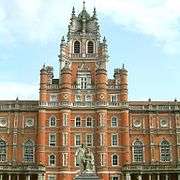Jane Holloway
Jane Holloway née Driver (1 November 1814 – 26 September 1875) was the inspiration for founding a women's college at Royal Holloway. Following her death, both Holloway Sanatorium and Royal Holloway were founded in her memory by her husband, Thomas Holloway.

Early life and business
Jane Pearce Driver was born in 1814. Her father was a shipwright from Rotherhithe.
In 1840, Jane married Thomas Holloway, after a period of courting where he nicknamed her "Grace Darling" after the famous Victorian heroine.[1][2] Jane took an active role in Holloway's business and is reported to have worked on the production line at The Strand during the early years.[2][3] Other members of her family soon also became involved in the promotion of Holloway's products, likely through Jane's influence. In later years, she accompanied Thomas on business trips abroad to promote the products.[2]
Death

Jane is buried alongside her husband in a family grave at Sunninghill churchyard
Philanthropic legacy
Jane placed the first brick at Holloway Sanatorium, followed by her husband Thomas.[4] He went on to complete the Sanatorium after death.
Jane was, according to Thomas, the inspiration behind the foundation of Royal Holloway. The Foundation Deed of Holloway College states that "the college is founded by the advice and counsel of the Founder's dear wife... to afford the best education for women of the Upper and Upper Middle Classes."[5]After her death, the college was founded by Thomas Holloway in her memory in 1879. Following the death of Thomas, the college was eventually opened in 1886 by Queen Victoria in the presence of Jane's brother-in-law, George Martin.[6]
Commemoration
Jane Holloway's married initials (JH) feature in the ceiling design of Holloway Sanatorium alongside those of her husband.[7] Jane Holloway is commemorated on the Royal Holloway campus with a statue. She is represented reviewing the plans set forth by her husband
References
- "Holloway, Thomas (1800–1883), manufacturer of patent medicines and philanthropist | Oxford Dictionary of National Biography". www.oxforddnb.com. doi:10.1093/ref:odnb/13577. Retrieved 2020-03-10.
- Holloway, Verity. (2016). Mighty Healer. Pen and Sword. ISBN 1-4738-5570-5. OCLC 975044859.
- Bolton, Sarah Knowles (1896). Famous Givers and Their Gifts. New York/Boston: Thomas Y. Cromwell & co. pp. 91.
- "Institutionalizing the Insane in Nineteenth-Century England". 2015-10-06. doi:10.4324/9781315654430. Cite journal requires
|journal=(help) - Hobsbawm, Eric J. (1989). The age of empire, 1875-1914 (1st Vintage books ed ed.). New York: Vintage. pp. 165. ISBN 0-679-72175-4. OCLC 18907020.
- "Our founders". www.royalholloway.ac.uk. Retrieved 2020-03-10.
- Knowles, Jane (1997). "The conversion of Holloway Sanatorium". Psychiatric Bulletin. 21 (4): 232–232. doi:10.1192/pb.21.4.232. ISSN 0955-6036.
